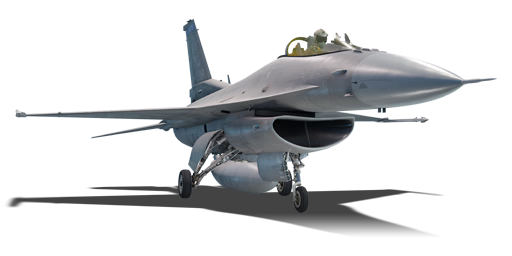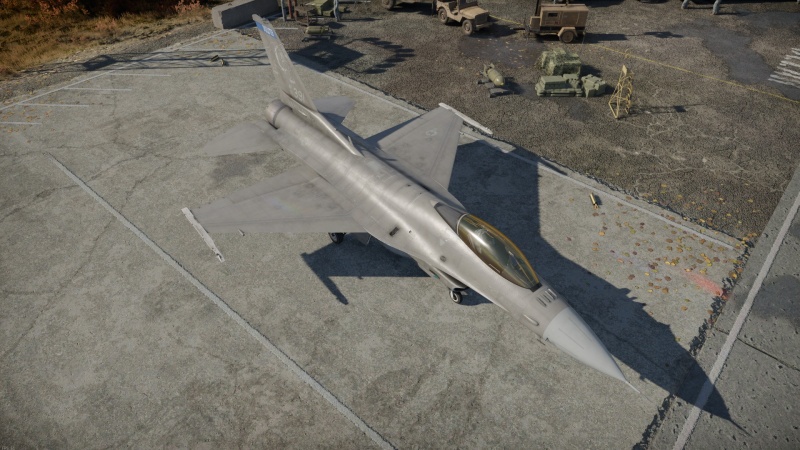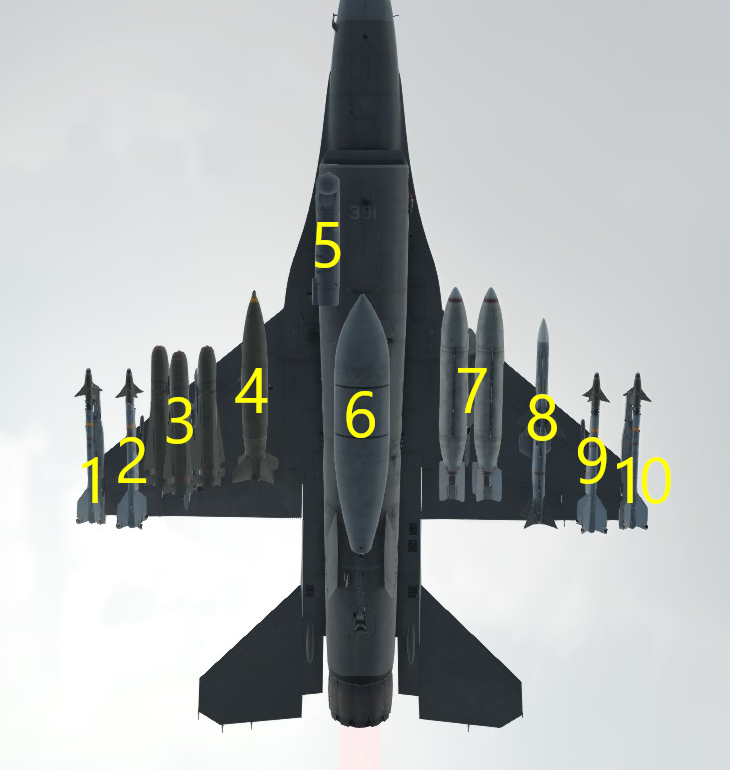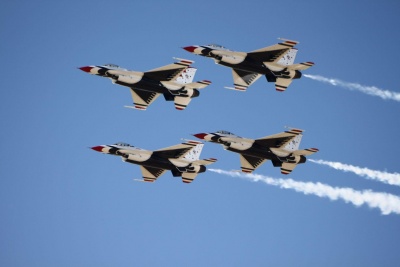Difference between revisions of "F-16C"
(→Description) |
(→Suspended armament: Updated) |
||
| Line 152: | Line 152: | ||
|- | |- | ||
! !! width="4%" | 1 !! width="4%" | 2 !! width="4%" | 3 !! width="4%" | 4 !! width="4%" | 5 !! width="4%" | 6 !! width="4%" | 7 !! width="4%" | 8 !! width="4%" | 9 !! width="4%" | 10 | ! !! width="4%" | 1 !! width="4%" | 2 !! width="4%" | 3 !! width="4%" | 4 !! width="4%" | 5 !! width="4%" | 6 !! width="4%" | 7 !! width="4%" | 8 !! width="4%" | 9 !! width="4%" | 10 | ||
| − | | rowspan=" | + | | rowspan="19" width="30%" | <div class="ttx-image">[[File:Hardpoints_{{PAGENAME}}.png]]</div> |
|- | |- | ||
! [[LDGP Mk 82 (500 lb)|500 lb LDGP Mk 82]] bombs | ! [[LDGP Mk 82 (500 lb)|500 lb LDGP Mk 82]] bombs | ||
| Line 183: | Line 183: | ||
! [[AGM-65D]] missiles | ! [[AGM-65D]] missiles | ||
| || || 1, 3 || || || || || 1, 3 || || | | || || 1, 3 || || || || || 1, 3 || || | ||
| + | |- | ||
| + | ! [[AGM-65G]] missiles | ||
| + | | || || 1 || || || || || 1 || || | ||
|- | |- | ||
! [[AIM-7M Sparrow]] missiles | ! [[AIM-7M Sparrow]] missiles | ||
| Line 198: | Line 201: | ||
! 300 gal drop tanks | ! 300 gal drop tanks | ||
| || || || || || 1 || || || || | | || || || || || 1 || || || || | ||
| + | |- | ||
| + | ! 370 gal drop tanks | ||
| + | | || || || 1 || || || 1 || || || | ||
|- | |- | ||
| colspan="11" | Maximum permissible weight imbalance: 2,000 kg | | colspan="11" | Maximum permissible weight imbalance: 2,000 kg | ||
|- | |- | ||
| colspan="12" | * The LITENING II pod must be equipped when carrying guided bombs | | colspan="12" | * The LITENING II pod must be equipped when carrying guided bombs | ||
| + | |- | ||
|} | |} | ||
{{Navigation-Start|Default weapon presets}} | {{Navigation-Start|Default weapon presets}} | ||
{{Navigation-First-Simple-Line}} | {{Navigation-First-Simple-Line}} | ||
| − | + | * 2 x 370 gal drop tanks + 1 x 300 gal drop tank | |
| − | * 1 x 300 gal drop tank | ||
* 2 x AIM-9L Sidewinder missiles | * 2 x AIM-9L Sidewinder missiles | ||
* 6 x AIM-9L Sidewinder missiles | * 6 x AIM-9L Sidewinder missiles | ||
| Line 216: | Line 222: | ||
* 2 x AGM-65D missiles | * 2 x AGM-65D missiles | ||
* 6 x AGM-65D missiles | * 6 x AGM-65D missiles | ||
| + | * 2 x AGM-65G missiles | ||
* 12 x 500 lb LDGP Mk 82 bombs (6,000 lb total) | * 12 x 500 lb LDGP Mk 82 bombs (6,000 lb total) | ||
* 12 x 500 lb Mk 82 Snakeye bombs (6,000 lb total) | * 12 x 500 lb Mk 82 Snakeye bombs (6,000 lb total) | ||
Latest revision as of 08:05, 15 March 2024
| This page is about the American jet fighter F-16C. For other versions, see F-16 (Family). |
Contents
Description
The F-16C Block 50 Fighting Falcon was a major improvement over the previous variants of the F-16. The previous Block 42 aircraft weighed 3,000+ lb (1,360 kg) over the early F-16s. To offset the increased weight, General Electric developed the F110-GE-129 which greatly increased thrust at both low and high altitudes. The Block 50 also received the Westinghouse APG-68(v)5 radar (upgraded to the -68(v)7 in later production models) which was much faster and generally more reliable. One of the biggest additions to the Block 50 was the ability to fire new ground attack munitions. The USAF received the first F-16 Block 50 in late 1991 and many more were sent to foreign countries as well.
Introduced in Update "Sons of Attila", the F-16C Block 50 Fighting Falcon is an excellent top-tier aircraft. The improved General Electric F110 greatly increases the performance of the Block 50 against enemy aircraft. It excels in dogfighting thanks to its relatively light airframe and better engine. The Fighting Falcon has access to AIM-9M Sidewinders with a smokeless motor and improved IRCCM, making them an incredibly dangerous missile, especially from rear aspect. Players should be more than satisfied with the F-16C Block 50 against both aircraft and ground targets.
General info
Flight performance
The F-16C performs similarly to the F-16A ADF, with a better engine and roll rate. When the plane is heavy (full fuel load, lots of ordnance), its maneuverability isn't amazing, but it isn't bad. However, when the plane is light (low fuel and most of the ordnance is depleted), it is much more maneuverable and is one of the best dogfighters in the game. It has a great roll rate, but this is only with the "New boosters" modification. This mod is incredibly potent, drastically increasing roll rate. It's incredibly quick as well, hitting 1500+ km/h on the deck coming at the cost of maneuverability, which is especially noticeable without the boosters.
It turns incredibly well, but the pilot needs to manage speed as it won't turn very well at high speed, especially when compared to an F-14 or MiG-29.
The engine is very strong, giving the F-16C a favorable thrust-to-weight ratio and climb rate. Due to the weight of its upgrades, however, it's not as maneuverable as the earlier F-16 variants, but is still an excellent aircraft.
| Characteristics | Max speed (km/h at 10,973 m) |
Max altitude (metres) |
Turn time (seconds) |
Rate of climb (metres/second) |
Take-off run (metres) | |||
|---|---|---|---|---|---|---|---|---|
| AB | RB | AB | RB | AB | RB | |||
| Stock | 2,108 | 2,073 | 15240 | 20.1 | 20.5 | 259.5 | 248.3 | 850 |
| Upgraded | 2,235 | 2,170 | 18.9 | 19.5 | 344.1 | 300.0 | ||
Details
| Features | |||||
|---|---|---|---|---|---|
| Combat flaps | Take-off flaps | Landing flaps | Air brakes | Arrestor gear | Drogue chute |
| X | ✓ | ✓ | ✓ | ✓ | X |
| Limits | ||||||
|---|---|---|---|---|---|---|
| Wings (km/h) | Gear (km/h) | Flaps (km/h) | Max Static G | |||
| Combat | Take-off | Landing | + | - | ||
| 1,555 | 482 | - | 470 | 463 | ~12 | ~4 |
| Optimal velocities (km/h) | |||
|---|---|---|---|
| Ailerons | Rudder | Elevators | Radiator |
| < 680 | < 750 | < 700 | - |
Engine performance
| Engine | Aircraft mass | ||||||
|---|---|---|---|---|---|---|---|
| Engine name | Number | Basic mass | Wing loading (full fuel) | ||||
| General Electric F110-GE-129 | 1 | 9,070 kg | 441 kg/m2 | ||||
| Engine characteristics | Mass with fuel (no weapons load) | Max Gross Weight | |||||
| Weight (each) | Type | 12m fuel | 20m fuel | 30m fuel | 42m fuel | ||
| 1,805 kg | Afterburning low-bypass turbofan | 10,044 kg | 10,606 kg | 11,374 kg | 12,317 kg | 17,874 kg | |
| Maximum engine thrust @ 0 m (RB/SB) | Thrust to weight ratio @ 0 m (WEP) | ||||||
| Condition | 100% | WEP | 12m fuel | 20m fuel | 30m fuel | 42m fuel | MGW |
| Stationary | 6,960 kgf | 11,484 kgf | 1.14 | 1.08 | 1.01 | 0.93 | 0.64 |
| Optimal | 7,241 kgf (1,200 - 1,400 km/h) |
16,488 kgf (1,200 km/h) |
1.64 | 1.55 | 1.45 | 1.34 | 0.92 |
Survivability and armour
The F-16C has no armour and, as such, lackluster survivability. The aircraft's inherent instability is exacerbated with damage, as well; it is very hard to fly if you lose a wing or your tail, and even minor airframe damage can cause the jet to enter a flatspin, or at the very least hinder its maneuverability.
Modifications and economy
Armaments
| Ballistic Computer | ||||
|---|---|---|---|---|
| CCIP (Guns) | CCIP (Rockets) | CCIP (Bombs) | CCRP (Bombs) | Lead indicator |
| |
|
|
|
|
Offensive armament
The F-16C is armed with:
- 1 x 20 mm M61A1 cannon, wing root-mounted (512 rpg)
- 120 x countermeasures
Suspended armament
The F-16C can be outfitted with the following ordnance:
| 1 | 2 | 3 | 4 | 5 | 6 | 7 | 8 | 9 | 10 | ||
|---|---|---|---|---|---|---|---|---|---|---|---|
| 500 lb LDGP Mk 82 bombs | 3 | 3, 6 | 3, 6 | 3 | |||||||
| 500 lb Mk 82 Snakeye bombs | 3 | 3, 6 | 3, 6 | 3 | |||||||
| 2,000 lb LDGP Mk 84 bombs | 1 | 1 | 1 | 1 | |||||||
| 2,000 lb LDGP Mk 84 Air bombs | 1 | 1 | 1 | 1 | |||||||
| 277 kg GBU-12 Paveway II bombs | 2* | 2* | |||||||||
| 2,000 lb GBU-24 Paveway III bombs | 1* | 1* | 1* | 1* | |||||||
| BLU-27/B incendiary bombs | 2 | 2 | 2 | 2 | |||||||
| FFAR Mighty Mouse rockets | 57 | 57 | |||||||||
| Hydra-70 M247 rockets | 19 | 19 | |||||||||
| AGM-65D missiles | 1, 3 | 1, 3 | |||||||||
| AGM-65G missiles | 1 | 1 | |||||||||
| AIM-7M Sparrow missiles | 1 | 1 | |||||||||
| AIM-9L Sidewinder missiles | 1 | 1 | 1 | 1 | 1 | 1 | |||||
| AIM-9M Sidewinder missiles | 1 | 1 | 1 | 1 | 1 | 1 | |||||
| LITENING II targeting pod | 1* | ||||||||||
| 300 gal drop tanks | 1 | ||||||||||
| 370 gal drop tanks | 1 | 1 | |||||||||
| Maximum permissible weight imbalance: 2,000 kg | |||||||||||
| * The LITENING II pod must be equipped when carrying guided bombs | |||||||||||
| Default weapon presets | |
|---|---|
| |
Usage in battles
The F-16C is a purebred squad fighter, performing most efficiently with allied help. A group of 3–4 F-16s is a deadly force to be reckoned with, no matter the enemy. To get the most out of the Block-50, focus on assisting allies and cleaning up baited targets. The F-16 can be a menace by dipping in and out of fights, utilizing its effective HMD to sling AIM-9Ms at slow and distracted opponents. However, due to poor high-speed manoeuvrability, the F-16 should never be found alone, especially by multiple enemies. Poor high-speed agility can reduce responsiveness times for pilots, giving pursuing enemies crucial space for positioning. The F-16 can be easily overwhelmed when outnumbered, so the best way to combat the weakness is to avoid it altogether. By using careful target prioritization, a Block-50 can kill enemies and free up allies for assistance at the same time. Through practice, you will learn your plane by heart, finally unleashing the full potential of this vicious aircraft.
Pros and cons
Pros:
- Access to potent AIM-9M missiles with the bonus of a smokeless motor
- Access to a LITENING II TGP in contrast to other F-16 variants
- Large variety of guided ground ordnance
- Better radar than previous F-16s
- Has TWS (Track While Scan)
- Upgraded F110-GE-129 engine with significantly more thrust
- Advanced AN/ALR-56M RWR that can detect a variety of threats
- Access to a voice warning system (Betty)
- Access to a helmet-mounted display (JHMCS) that allows players to obtain and fire missiles off the boresight
Cons:
- Bad top speed manoeuvrability
- High fuel consumption
- Worse flight performance than previous F-16s
History
Concluding MSIP III, the Block 40/42 F-16CG/DG "Night Falcon" fleet weighed 3,000+ lbs over the original F-16A/B fleet. Intended to carry more armament than the original A/Bs, the CG/DGs had their airframes strengthened compared to even the fairly recent CD/DDs, and had improved avionics, as the primary intent behind the Night Falcon: LANTIRN integration. While this wasn't as much of a problem for the Block 40s, the Block 42s suffered heavily, still using the F100-PW-220E introduced with the Block 25. These engines still produced roughly the same thrust as the original F100-PW-200s that was featured on the F-16As.
As a result, the USAF launched the Increased Performance Engine (IPE) program to increase the thrust of the F-16. Pratt & Whitney procured the F100-PW-229, and General Electric procured the F110-GE-129, both rated at 29,000 lb of thrust (129 kN). Both were much more powerful than their predecessors, providing the Block 50/52 fleet much desired thrust. The F110, found in the Block 50, featured a thirty-percent increase in thrust at low altitudes and a ten-percent increase at higher altitudes. The Block 50 also received the Westinghouse APG-68(v)5 radar which had increased reliability and was much faster. The cockpit retained its previous monochrome MFDs and FOV HUD, while having upgraded systems, such as the AN/ALR-56M RWR and AN/ALE-47 countermeasure system. From the Block 50D/52D onwards, the Block 50/52 fleet was unofficially designated the F-16CJ/DJ. These F-16s received the Harm Avionics/Launcher Interface Computer (ALIC), allowing for autonomous employment capability of HARMs, and the integration for AGM-88 HARMs, the Lockheed Martin AN/AAS-35(V) Pave Penny laser spot tracker (also featured on the right hand side of the A-10A's and early A-10C (pre Suite 7, as this was superseded by more system integration)'s nose), and the Texas Instruments (now Raytheon) AN/ASQ-213 Harm Targeting System (HTS). The HTS is mounted on the starboard intake hardpoint, and is able to detect, classify, and range ground radar threats, passing this information to the HARM and cockpit displays. The Block 50 was also capable of using new munitions, such as the AGM-65G Maverick, JDAM munitions, AGM-154 JSOW, AGM-84 Harpoon anti-ship missiles, and PGU-28/B SAPHEI rounds.
The first Block 50 F-16 was delivered to the USAF in November of 1991, and by early 1997, over 300 were delivered to four different customers.
After 2005, the USAF stopped receiving new F-16s, although they continued to upgrade their fleet, as seen with the Common Configuration Implementation Program (CCIP), and Post Block Integration Team (PoBIT).
The CCIP brought the Block 40/42 fleet and 50/52 fleet to the same upgrade program, including upgrades such as a more powerful central processor, color cockpit displays, the Sniper XR targeting pod (Phase IB), the "Joint Helmet-Mounted Cueing System" (JHMCS) (Phase II), the AN/APX-113 IFF transponder (as seen with the "bird slicers" on the top of the nose of the F-16C in game), an improved Westinghouse APG-68(v)9 radar, electronic Horizontal Situation Indicator, and the Link-16 data link, amongst other improvements. This upgrade also provided shared commonality with the well-known Mid-Life Upgrade (MLU) program, bringing the now combined 40/42/50/52 fleet to about M4.2 standard, though this varied depending on the airframe. The US F-16 fleet also ran through a Service Life Extension Program (SLEP) parallel to CCIP, providing valuable structural refurbishment to ensure the airframe's survivability, increasing the original 8,000 flight hours to nearly 14,000. These modernized F-16s were redesignated as F-16CM/DM regardless of block, further signifying commonality with MLU F-16s.
Smaller individual upgrades have taken place, too, such as integration of more advanced countermeasures systems such as Raytheon's AN/ALE-50 towed decoy system, and Elbit System's Passive Airborne Warning Systems (PAWS). Larger upgrades include the Block 50/52 Plus, which includes many upgrades seen in CCIP (such as AN/APX-113, APG-68(v)9, HMCS capability), while also adding features such as an on-board oxygen generating system (OBOGS), and the capability for Conformal Fuel Tanks (CFTs). D variant Block 50/52 Pluses also have a distinct spine, accommodating for lost space involved with integrating the second seat, although the spines seen on F-16s heavily vary depending on the operator and Block. The Have Glass programs are dedicated to minimizing the F-16's radar cross section throughout the platform's lifetime. The most modern iteration, Have Glass V, utilizes ferromagnetic paint.to absorb radar energy, and recoats the canopy in a distinctive, darker finish.
A variety of nations operate the Block 50/52 to this day, including but not limited to Chile, Egypt, Greece, Iraq, Israel, Poland, Singapore, South Korea, and Turkey. Each customer has their own separate upgrades involved, depending on the nation's need.
Media
- Skins
- Images
- Videos
See also
- Related development
External links
| General Dynamics Corporation | |
|---|---|
| Jet Fighters | F-16A · F-16A ADF · F-16C |
| Strike Aircraft | F-111A |
| Export | Netz · Barak II · ▄F-16A ADF · ␗F-16A MLU · F-16AJ |
| USA jet aircraft | |
|---|---|
| Fighters | |
| F-4 | F-4C Phantom II · F-4E Phantom II · F-4J Phantom II · F-4S Phantom II |
| F-5 | F-5A · F-5C · F-5E · F-20A |
| F-8 | F8U-2 · F-8E |
| F-80 | F-80A-5 · F-80C-10 |
| F-84 | F-84B-26 · F-84F · F-84G-21-RE |
| F-86 | F-86A-5 · F-86F-25 · F-86F-2 · F-86F-35 |
| F-89 | F-89B · F-89D |
| F-100 | F-100D |
| F-104 | F-104A · F-104C |
| F-14 | F-14A Early · F-14B |
| F-15 | F-15A |
| F-16 | F-16A · F-16A ADF · F-16C |
| F9F | F9F-2 · F9F-5 · F9F-8 |
| Other | P-59A · F2H-2 · F3D-1 · F3H-2 · F4D-1 · F11F-1 |
| Strike Aircraft | |
| FJ-4 | FJ-4B · FJ-4B VMF-232 |
| A-4 | A-4B · A-4E Early |
| A-6 | A-6E TRAM |
| A-7 | A-7D · A-7E · A-7K |
| AV-8 | AV-8A · AV-8C |
| A-10 | A-10A · A-10A Late |
| B-57 | B-57A · B-57B |
| F-105 | F-105D |
| F-111 | F-111A |








